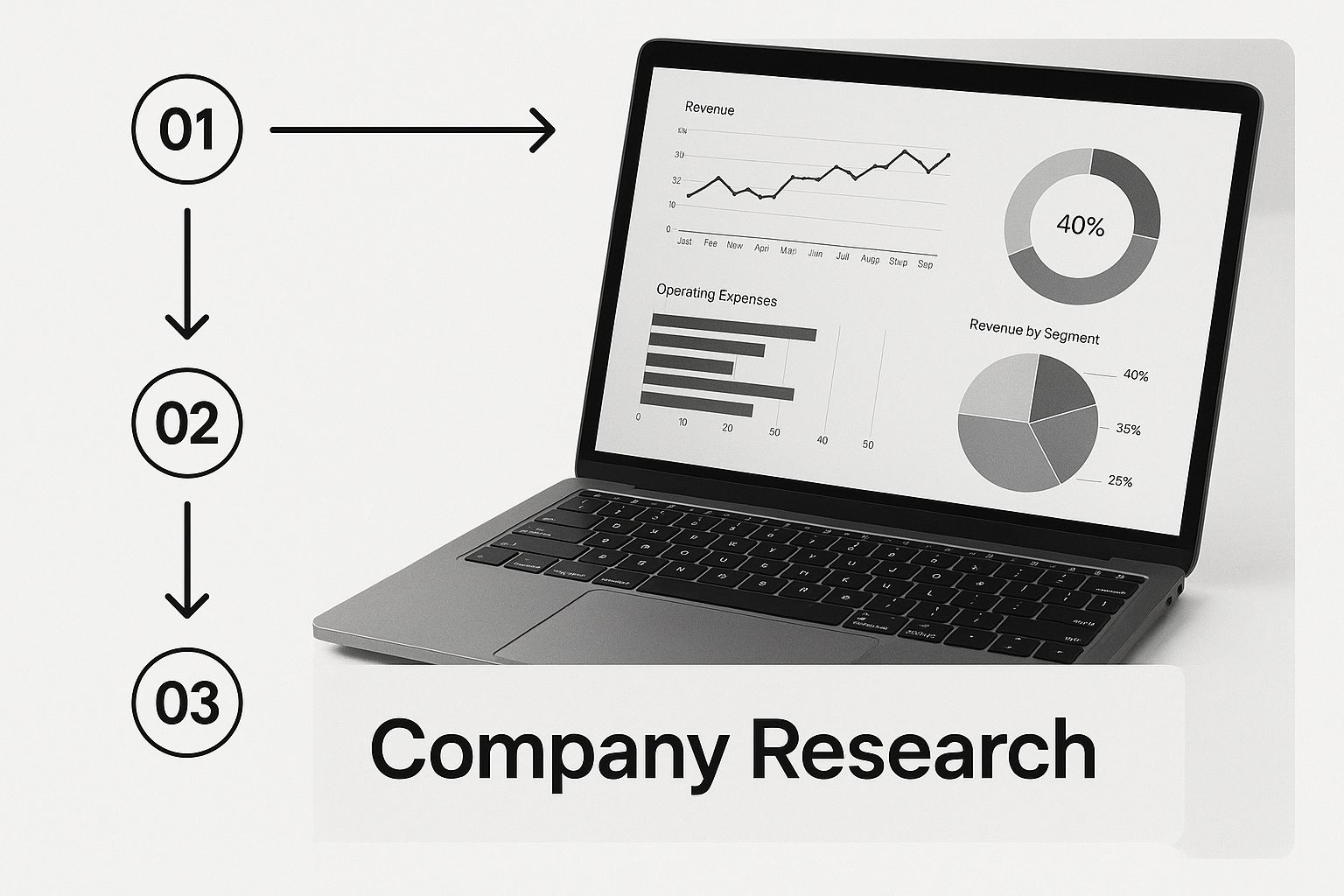Picking the right stocks starts with a simple, yet surprisingly overlooked idea: know yourself first.
Before you ever punch a ticker symbol into a search bar, your success really comes down to building a personal investment plan. This plan needs to be deeply connected to your life goals, your timeline, and what you’re actually comfortable with when it comes to risk. The path to investing is often filled with anxiety and self-doubt, but creating a solid plan is the best way to build confidence and navigate the noise.
Building Your Personal Investment Foundation

Before diving headfirst into analyzing companies, the most important thing you can do is build a framework for every decision you’ll make later on. This isn’t about chasing hot stock tips from a friend or a flashy headline. It’s about creating your own personal North Star to guide you through the inevitable market ups and downs.
We’ve all felt that pull to jump on a stock that everyone’s talking about—the fear of missing out is powerful. But without a solid foundation, emotion almost always takes the driver’s seat, and emotional decisions rarely lead to good outcomes.
Doing this initial work is what prevents those costly mistakes, like panic-selling during a market dip or chasing unrealistic returns. It’s the kind of disciplined, long-term thinking that separates successful investors from those who are just gambling. No strategy can guarantee profits, but a disciplined approach dramatically improves your odds of building wealth over time.
Define Your Investment Timeline
Your timeline is probably the single biggest factor that will shape your strategy. Are you investing for something decades away, or do you need this money in just a few years? The answer completely changes how you should approach picking stocks.
- Long-Term Goals (10+ years): This is for things like retirement or a child’s college fund. With a long horizon, you can afford to take on more risk for potentially higher returns because you have plenty of time to recover from any market downturns.
- Medium-Term Goals (5-10 years): Maybe you’re saving for a down payment on a house. Here, your strategy might be a more balanced mix of growth-oriented stocks and some more stable investments.
- Short-Term Goals (Under 5 years): If you’re saving for a new car or a big vacation, the stock market is often too volatile. The risk of losing your principal is just too high when you need the cash that soon.
Think about it: a 25-year-old saving for retirement can ride out the market’s ups and downs. Someone planning to buy a home in three years simply can’t afford that kind of setback. Your timeline dictates how much risk you can really handle.
“The stock market is a device for transferring money from the impatient to the patient.” – Warren Buffett
This timeless advice from Buffett really hits home. Patience, which is rooted in having a clear timeline, is your single greatest asset.
Honestly Assess Your Risk Tolerance
How would you really feel if your portfolio dropped by 20% in one month? Your honest, gut reaction to that question gives you a glimpse into your true risk tolerance. It’s easy to feel brave when the market is soaring, but your real comfort level shows up when things get rocky. Many traders feel a pit in their stomach during a downturn—that’s a normal human reaction. The key is to prepare for it.
Understanding this about yourself helps you avoid panic. If you know you’re a conservative investor, you can build a portfolio that lets you sleep at night. That alone will stop you from making the kind of emotional decisions that destroy wealth.
For example, history shows that even the broader market can be a rollercoaster. Over the last 150 years, the S&P 500 has delivered an average annual return of about 9.42% with dividends reinvested, but it has definitely seen some significant drops along the way. You can explore more on historical stock market returns to see for yourself.
Set Clear, Measurable Financial Goals
“I want to make more money” isn’t a goal; it’s a wish. A real, actionable goal is specific, measurable, and has a deadline.
Instead of that vague desire, try framing it like this: “I want to grow my investment portfolio to $100,000 in the next 10 years to use as a down payment for a home.”
This kind of clarity gives your investing a purpose and a benchmark to measure your progress. It turns an abstract idea into a tangible life objective, which makes it so much easier to stay disciplined when the market gets choppy. Your goals are the “why” behind every single stock you choose.
Learning to Read a Company’s Story
Once you’ve built your personal investment foundation, it’s time for the exciting part: learning how to actually pick a stock. A stock’s price can bounce around based on headlines or market moods, but its real, lasting value is tied to the health and performance of the business itself.
Many people get spooked by financial reports, but they aren’t as scary as they look. Think of them as a company’s report card. They tell a story about how the business makes money, what it owns, and where its cash is actually going. Let’s break down the essentials without the confusing jargon.
Decoding the Financials
To really get what a company is about, you need to glance at its three core financial statements. Each one gives you a different angle, and together, they create a full picture of the company’s stability and future potential.
- Income Statement: This one’s the most straightforward. It shows a company’s revenues (sales) and expenses over a certain period, like a quarter or a year. The bottom line you care about is the net income—the profit. You want to see both revenue and profit climbing steadily over time.
- Balance Sheet: Think of this as a snapshot in time. It shows what a company owns (assets) and what it owes (liabilities). A healthy company typically has way more assets than liabilities and isn’t drowning in debt.
- Cash Flow Statement: This tracks the actual cash moving in and out of the business. Here’s a pro tip: a company can look profitable on its income statement but still be bleeding cash. Positive cash flow is everything—it’s what companies use to reinvest, pay dividends, or kill off debt.
Don’t get lost in the weeds. Your goal is to see the big picture. Is the company consistently making money? Is its debt under control? Does it generate enough cold, hard cash to fuel its own growth? Answering these questions is the first step toward finding a fantastic long-term investment.
Key Metrics That Tell a Deeper Story
Beyond the big statements, a few simple ratios can give you some powerful shortcuts to understanding a company’s performance and whether its stock price is fair. They’re perfect for comparing companies in the same industry.
The table below breaks down a few of the most important metrics you’ll come across.
| Metric | What It Measures | What to Look For |
|---|---|---|
| Price-to-Earnings (P/E) Ratio | The stock’s price relative to its earnings per share. It’s a quick gauge of whether a stock is “expensive” or “cheap.” | A lower P/E might suggest a bargain, but context is key. Compare it to industry peers and the company’s own historical P/E. |
| Return on Equity (ROE) | How efficiently the company uses shareholder money to generate profit. It’s a measure of management effectiveness. | Consistently high ROE (think 15% or more) often points to a well-run business with a strong competitive edge. |
| Debt-to-Equity Ratio | A company’s total debt compared to its shareholder equity. It shows how much leverage a company is using. | A ratio below 1.0 is generally considered safe, but this varies by industry. Look for manageable debt levels. |
| Price-to-Book (P/B) Ratio | Compares a company’s market value to its book value (assets minus liabilities). | A P/B under 1.0 could mean the stock is undervalued, but it’s most useful for asset-heavy industries like banking or manufacturing. |
These ratios aren’t magic, but they provide a fantastic starting point for digging deeper and asking the right questions about a company’s financial health.
Price-to-Earnings (P/E) Ratio
This is probably the most famous valuation metric out there. It compares a company’s stock price to its earnings per share. A high P/E might mean the stock is overhyped, while a low P/E could signal a hidden gem. But context is everything—a fast-growing tech company like NVIDIA will naturally trade at a higher P/E than a steady, slow-growing utility company like Duke Energy.
Return on Equity (ROE)
ROE tells you how good a company is at turning investors’ money into more money. A consistently high ROE, say 15% or more, is often the mark of a well-managed business that knows what it’s doing.
Understanding the story behind the numbers is what separates investing from speculating. You’re not just buying a stock; you’re buying a piece of a business you believe in.
The Power of a Competitive Moat
Warren Buffett’s secret sauce is looking for companies with a durable “competitive moat”—a sustainable advantage that keeps competitors at bay. A strong moat lets a company protect its profits and market share for years, even decades. This is what turns a good company into a truly great investment.
So, what does a moat look like in the wild?
- Brand Strength: Just think of Coca-Cola or Apple. Their brands are so powerful that people willingly pay more for their products. Competitors can’t just copy that kind of loyalty.
- Network Effects: Companies like Visa or Facebook get more valuable as more people use their service. This creates a massive hurdle for anyone trying to build a new network from scratch.
- High Switching Costs: How much of a pain would it be for your company to ditch Microsoft Office for something else? That “stickiness” gives Microsoft incredible pricing power and a predictable stream of revenue.
Finding companies with wide moats is crucial for long-term success. Historical data shows that while the stock market delivers higher average returns over time, it comes with a lot of ups and downs. Data from NYU’s Stern School of Business confirms that since 1928, stocks have crushed bonds and bills but with some wild swings along the way. Companies with strong moats are simply better built to survive those downturns and thrive when things turn around. You can discover more about these long-term market trends to see why picking resilient businesses is so important.
When you learn to read a company’s story through its financials, key metrics, and competitive position, you stop being a stock-picker and start thinking like a business owner. And that’s a reliable path toward building wealth.
How to Find Great Companies with Stock Screeners
With thousands of publicly traded companies out there, how do you even begin to find the ones worth your time and money? It can feel like searching for a needle in a haystack. We’ve all been there—staring at an endless sea of ticker symbols until our eyes glaze over.
This is exactly where a stock screener comes in. It’s one of the most powerful tools in an investor’s arsenal.
A stock screener is software that filters the entire universe of stocks down to a manageable list based on criteria you define. Instead of manually digging through company after company, you just tell the screener what you’re looking for, and it does the heavy lifting for you.
It’s like walking into a massive library and telling the librarian you need a book on ancient history, written in the last five years, with at least a four-star rating. A screener does the same, but for stocks.
Setting Up Your First Screen
You don’t need to pay for a fancy service to get started. Plenty of excellent, free screeners are available from platforms like Yahoo Finance and Finviz. The goal isn’t to let a tool blindly pick stocks for you, but to efficiently find promising companies that deserve a closer look.
Let’s walk through a real-world example. Say you’re a growth-focused investor looking for solid companies. You could set up a screen with filters like these:
- Market Capitalization > $2 Billion: This weeds out the tiny, speculative stocks and focuses on more established mid-cap and large-cap companies.
- P/E Ratio < 25: This helps you find businesses that aren’t trading at sky-high valuations relative to their earnings.
- Revenue Growth (Past 5 Years) > 10%: A great way to target companies with a proven history of expanding their business.
- Debt-to-Equity Ratio < 0.5: This is a classic sign of financial health, showing that a company isn’t overloaded with debt.
A simple screen like this can take thousands of potential stocks and narrow them down to a few dozen candidates worthy of your attention.

From there, you can start digging deeper into the individual businesses to see if they truly fit your strategy.
Avoiding Common Screening Mistakes
Screeners are fantastic, but they come with a few pitfalls that can trip up investors. It’s a process that requires a bit of art to go with the science.
One of the most common mistakes is making your filters way too restrictive. If you demand a P/E ratio under 10, revenue growth over 30%, and absolutely zero debt, you’ll probably end up with zero results. The “perfect” company rarely exists on paper. It’s often better to start with broader criteria and then slowly tighten them.
Remember, a stock screener is a starting point, not a finish line. It helps you build a high-quality list for deeper research; it doesn’t give you a list of stocks to buy blindly.
Another trap is getting tunnel vision on a single metric. A company might have an incredibly low P/E ratio, which looks like a bargain at first glance. But if you look closer and see its revenue has been shrinking for three years straight, that low P/E is probably a warning sign, not a deal.
Always use a combination of metrics to get a complete picture. Your screener results are just the beginning of your homework, not the end of it.
Understanding the Bigger Economic Picture
Picking a great company is a huge step, but it’s only half the battle.
Even the healthiest business in the world doesn’t operate in a vacuum. It’s part of a massive, interconnected web of economic forces, industry shifts, and global events. Understanding this bigger picture is what elevates your thinking from a simple stock picker to a strategic investor.
We’ve all seen it happen: a fantastic company’s stock gets dragged down by a market-wide panic that has nothing to do with its actual performance. It’s frustrating, but it’s the reality of investing. Learning to zoom out and see the forest for the trees helps you anticipate these shifts instead of just reacting to them.
This skill is all about developing contextual awareness. It’s about asking, “How does this company fit into the world right now, and where is that world heading?” Answering that question can be the difference between getting blindsided and spotting a once-in-a-decade opportunity.
Connecting the Dots Between the Economy and Your Portfolio
Macroeconomic factors are the large-scale economic conditions that affect everyone. Think of them as the currents in the ocean—they can either push your boat forward or pull you way off course. Ignoring them is like setting sail without checking the weather forecast.
A few key factors have a powerful and direct impact on different types of companies:
- Interest Rates: When interest rates rise, borrowing gets more expensive. This can really hurt high-growth tech companies that rely on debt to fuel expansion. On the flip side, financial institutions like banks often see their profit margins improve.
- Inflation: High inflation eats away at consumer purchasing power. Companies selling essential goods, like Procter & Gamble, tend to hold up well because people still need to buy toothpaste. But businesses selling luxury items might struggle as households tighten their belts.
- Economic Growth (GDP): In a booming economy, cyclical sectors like travel (e.g., airlines and hotels), hospitality, and automotive thrive as people spend more freely. During a recession, these are often the first areas to see a slowdown.
You don’t need a PhD in economics to get a handle on these concepts. The goal is to simply connect these big-picture trends to the industries and companies you’re researching.
A rising tide lifts all boats, but an outgoing tide can reveal which ones were swimming naked. Understanding the economic cycle helps you see which companies are built to withstand the storm.
Industry Trends and Government Policies
Beyond broad economic indicators, you have to look at the specific environment an industry operates in. A new piece of government legislation or a disruptive technology can completely reshape a sector overnight, creating clear winners and losers.
Take the recent push toward renewable energy. Government incentives and shifting consumer preferences have created massive tailwinds for companies in the solar and electric vehicle spaces. Meanwhile, traditional energy companies are facing new pressures to adapt. This doesn’t mean one is “good” and the other is “bad”—but the context is critical for understanding their future growth prospects.
Similarly, the political environment plays a huge role. Investor decision-making often incorporates market performance under different administrations, along with economic indicators. For example, solid economic growth and strong consumer spending helped the S&P 500 generate significant annual returns in both 2023 and 2024. These historical patterns highlight why it’s wise to monitor macroeconomic policies right alongside a company’s financial metrics. You can explore more on how market conditions influence investor decisions to get a deeper sense of this.
This broader view is a key piece of a complete investment strategy. To put all these pieces together effectively, you can read our detailed guide on market analysis techniques, which helps you integrate both company-specific data and macroeconomic trends. This holistic approach ensures you aren’t caught off guard by market-wide movements you could have seen coming.
Building a Portfolio That Lets You Sleep at Night
So you’ve done the hard work. You found a fantastic company with strong fundamentals and what looks like a bright future. That’s a huge win, but picking a great stock is only half the battle.
The other, equally vital piece of the puzzle is protecting your hard-earned money.
We’ve all felt that sting of watching a single stock plummet, dragging our entire portfolio down with it. It’s a painful lesson, but it teaches a critical truth: even the best companies can face unexpected headwinds. The key is to build a portfolio that can absorb those shocks, so one bad apple doesn’t spoil the whole bunch. This is where smart risk management comes in.
This isn’t about trying to eliminate risk entirely—that’s impossible. It’s about managing it intelligently so you can stay in the game for the long haul, without the emotional rollercoaster that causes so many investors to make costly mistakes.
The Power of True Diversification
You’ve heard the old saying, “Don’t put all your eggs in one basket.” In investing, that basket is your portfolio, and true diversification is about much more than just owning a few different stocks.
For example, owning five different big-name tech stocks doesn’t mean you’re diversified. It just means you’re heavily exposed to a single sector. If a new regulation hits the tech industry, your entire lineup could take a hit.
Real diversification means spreading your investments across various, non-related industries. Your portfolio might include:
- A healthcare company (e.g., Johnson & Johnson)
- A consumer staples business (e.g., Procter & Gamble)
- An industrial machinery manufacturer (e.g., Caterpillar)
- A financial services firm (e.g., JPMorgan Chase)
When you spread your money across different sectors, a downturn in one area won’t sink your entire portfolio. Other sectors might hold steady or even thrive, balancing out the losses. It’s one of the most effective ways to smooth out your returns over time. To dig deeper, you can explore our guide on how to diversify an investment portfolio effectively.
Position Sizing Your Way to Lower Risk
Once you’ve decided on a stock, the next critical question is: how much should you actually buy? This is where position sizing comes into play, and it’s a simple but powerful technique for controlling risk. It’s all about deciding what percentage of your total portfolio you’ll allocate to a single company.
A common rule of thumb is to not let any single stock make up more than 5% of your total portfolio value.
Let’s run the numbers. If you have a $10,000 portfolio, this rule means you’d invest no more than $500 into any one company. This automatically caps your downside. If that one stock goes to zero—an unlikely but possible scenario—your total portfolio only takes a 5% hit. It’s a setback, not a catastrophe. This simple discipline keeps you from getting overexposed to any single company’s fate.
Taming Your Inner Investor Emotions
Often, the biggest risk in investing isn’t the market—it’s you. Our own emotions, fear and greed, are responsible for some of the biggest wealth-destroying mistakes investors make. Fear makes us panic-sell at the bottom, and greed pushes us to chase overhyped stocks at the top. It’s a struggle every single investor faces, from beginners to seasoned pros.
Successful investing is about having a plan and the discipline to stick with it. It’s about letting your research, not your gut feelings, guide your decisions during periods of market stress.
Studies consistently show that investors who trade frequently based on emotion underperform those who follow a disciplined strategy. It’s incredibly difficult to time the market, and trying to do so often leads to the classic mistake of buying high and selling low.
The best defense is a good offense. Have a clear plan for every stock you buy. Know why you’re investing and decide in advance what conditions would make you sell. This creates a logical framework that helps you stay calm and objective when the market gets choppy, giving you the resilience to let your portfolio grow.
Your Final Checklist Before You Buy

You’ve done the hard work. You’ve crunched the numbers, analyzed the industry, and you’re feeling confident about a stock. But hold on. Before you actually click that “buy” button, there are a few final checks that can make a world of difference. This is where you ground your decision in logic and make sure you’re entering the market on your terms.
One of the most powerful habits you can build is creating a simple investment thesis. This isn’t some complicated academic paper. It’s just a short, clear paragraph explaining exactly why you believe this company is a smart investment.
Think of it like this: “I’m buying Company XYZ because its brand loyalty gives it a real edge. Plus, it’s shown consistent 15% revenue growth every year and keeps its debt low. Their move into a new market feels like a clear catalyst for future growth.”
This little exercise does something crucial: it forces you to articulate your logic. When the market inevitably gets choppy, you can look back at this thesis and make a calm, objective decision instead of panic-selling based on fear or hype.
Placing Your Order The Smart Way
Now for the practical part: how you actually buy the shares. You’ve got two main options when placing a trade, and knowing the difference is key to getting a price you’re happy with.
- Market Order: This is the “get it now” option. It buys the stock immediately at whatever the best available price is at that exact second. It’s fast and guarantees you get in, but you might pay a few cents more or less than what you saw on the screen.
- Limit Order: This puts you in control. You set the maximum price you’re willing to pay per share. Your order only goes through if the stock price hits your target or drops lower.
For most long-term investors, a limit order is the more disciplined route. It prevents you from overpaying in the heat of the moment. Another great long-term strategy to look into is understanding what dollar-cost averaging is, which can help smooth out your entry price over time.
The Power of an Investment Journal
Last but not least, start an investment journal. It doesn’t need to be fancy—a simple notebook or spreadsheet works just fine. Just make a habit of jotting down your thesis, your entry price, and your thinking at the time.
Doing this turns every single investment—whether it’s a winner or a loser—into a priceless learning experience. Over time, you’ll start to see patterns in your own decision-making, allowing you to fine-tune your process and become a more confident, successful investor.
Common Questions About Picking Stocks
Even with a solid plan, you’re going to have questions. We’ve all been there, staring at a stock chart wondering if we’re making the right move. Let’s tackle some of the most common questions new investors have when they’re learning how to pick stocks.
How Many Stocks Should a Beginner Invest In?
Jumping in can feel overwhelming, but you don’t need to buy dozens of stocks right away. A great starting point for a beginner is to build a portfolio of 10 to 15 stocks spread across different industries.
Why that number? It’s the sweet spot. It’s manageable enough that you can still do deep-dive research on each company without getting buried. At the same time, it gives you enough diversification to protect your capital if one or two of your picks don’t pan out. Holding fewer than five stocks, for example, puts you in a risky spot where one company’s bad quarter could seriously damage your portfolio.
What Is the Difference Between Fundamental and Technical Analysis?
Think of these as two completely different lenses for looking at the market. Both are useful, but they answer different questions.
- Fundamental Analysis is all about playing detective with a business. You’re digging into financial statements, management quality, and competitive moats to figure out a company’s real, long-term value. This helps you answer the big question: “What company should I buy?”
- Technical Analysis is more about reading the crowd’s psychology through charts. You’re studying price charts and trading volume, looking for patterns that might suggest where the stock is headed in the short term. This helps you answer the timing question: “When should I buy or sell?”
For anyone focused on building lasting wealth, fundamental analysis is your true north. It grounds every decision in the actual health and performance of the business, not just the market’s mood swings.
The best investors don’t just “play the market”—they invest in businesses they genuinely understand and believe in for the long haul. That entire mindset is built on a foundation of solid fundamental research.
How Do I Know When It Is Time to Sell a Stock?
Knowing when to sell is just as critical as knowing when to buy, and it’s often much harder emotionally. The key is to make your decision with a cool head, based on logic, not fear. Never sell just because the market is panicking or your stock dipped a bit—if the business itself is still strong.
Instead, set clear rules for yourself ahead of time. You should consider selling when:
- The Fundamentals Have Deteriorated: The company is losing its edge, debt is piling up, or growth has stalled for good.
- The Stock Becomes Wildly Overvalued: Your own research shows the price has run far ahead of its intrinsic value. It’s a great time to lock in profits.
- You Find a Better Opportunity: You’ve identified another company with much stronger growth potential for your capital.
A great way to stay objective is by tracking your decisions. With the TradeReview trading journal, you can log your investment thesis for every stock you buy and sell, helping you learn from every trade and make smarter, data-driven decisions. Get started for free and refine your strategy today.


